
Shrubs
CROCOSMIA
Common Name: Crocosmia
Genus: Crocosmia
Exposure: Full sun, Partial shade
Hardiness: Hardy
Soil type: Well-drained/light, Clay/heavy, Acidic, Chalky/alkaline
Height: 100cm
Spread: 60cm
Flowering period: August to September
Crocosmias produce dense clumps of upright iris-like foliage. In midsummer this makes a good background for the small, profuse flowers. ‘Lucifer’ is an aptly-named variety because its flowers are the hottest coloured of all – a searing paprika red. The individual blooms are not as big as other crocosmias’, but small-flowered varieties such as this are the hardiest which makes them a wise choice in cold districts. Grown in a flower border, they provide structure and colour.
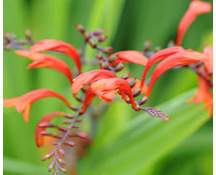
SEDUM
Common Name: Sedum
Genus: Sedum
Species: spectabile
Cultivar: ‘Brilliant’
Exposure: Full sun
Hardiness: Hardy
Soil type: Well-drained/light, Dry, Sandy
Height: 45cm
Spread: 45cm
This is an old-fashioned perennial forming blue-green rosettes of succulent foliage throughout summer. Towards mid-summer, flat tightly-packed heads of green buds form, opening later in the year to reveal masses of tiny bright pink flowers. Sedum is highly attractive to butterflies and insects, and several species can be found crowding over the flowers, making an additional attraction in the autumn garden.

FUCHSIA – FUCHSIA MAGELLANICA
When other fuchsias fail to survive the winter, this robust species from South America can be relied upon to retain a framework of branches. The purple and red flowers are small but borne profusely throughout summer. This plant succeeds in any well-drained soil and prefers partial shade to full sun. A very ornamental plant, it is a parent of many of the hardy ornamental fuchsia varieties. Height 2m. Flowers from July to October.
CONEFLOWER
Common Name: Coneflower
Genus: Rudbeckia
Exposure: Full sun, Partial shade
Hardiness: Hardy
Soil type: Well-drained/light, Clay/heavy, Moist
Height: 60cm
Spread: 60cm
Flowering period: August to October
The 13cm (5in) wide, black-eyed, single, yellow daisy flowers of Rudbeckia fulgida var. sullvantii ‘Goldsturm’ are what make it one of many gardeners’ top ten perennials. This variety has an incredibly long flowering season, from mid-summer right through to the middle of autumn when the first severe frosts arrive. The plant is short enough not to need staking, and does not spread so fast that frequent division is necessary, making it a very easy-care plant. Use it between other plants in a flower border, as it tolerates light shade, to extend the flowering season late into the year.

CARDINAL FLOWER
Common Name: Cardinal flower
Genus: Lobelia
Exposure: Full sun, Partial shade
Hardiness: Hardy
Soil type: Clay/heavy, Moist, Boggy Soil
Height: 90cm
Spread: 30cm
Flowering period: June to August
This species of Lobelia is a stately, upright plant, grown for both its purple-tinged foliage, most pronounced in the variety ‘Queen Victoria’ which has bold reddish-purple leaves, and brilliant red flowers, each 2.5cm (1in) across. These form tall spikes at the top of the plants from late summer into autumn. Although the plant itself is quite unlike bedding lobelia in appearance, the individual flowers have a similar shape, but are much bigger. This plant is rather short-lived, with plants usually lasting about three years.
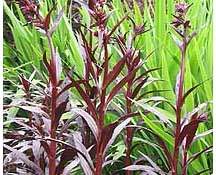
PHOTINIA – PHOTINIA FRASERI RED ROBIN
The young foliage is bright red in spring, changing to a deep green as it matures. In time the shrub can reach 3m. Photinia grows well in neutral and chalky soils. If you cut back new growth once it has lost its colour – new red growth will appear.

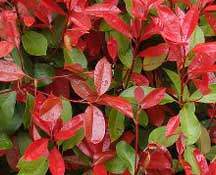
HOLLY
Common Name: Holly
Genus: Ilex
Species: x altaclerensis
Cultivar: ‘Golden King’
Exposure: Full sun, Partial shade
Soil type: Any reasonable soil
Height: 6m
Spread: 3m
Found over a century ago growing in a garden, this is just one of several popular varieties of a garden hybrid, I. x altaclerensis, bred partly from the common English holly, I. aquifolium. It is very hardy and tolerates most soils, as well as seaside air and atmospheric pollution, and fruits well in sun or shade. The handsome variegated leaves are quite flat and shapely, totally free from spines and ornamented with a prominent irregular golden yellow edge. Grow near a male plant for good crops of berries.
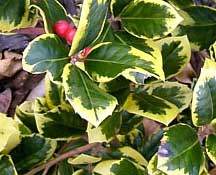
HOLLY
Common Name: Holly
Genus: Ilex
Species: aquifolium
Cultivar: Green
Exposure: Full sun, Partial shade
Soil type: Any reasonable soil
This is a slow growing evergreen. It requires little maintenance and acts as a good deterrent because of its prickly leaves. It may also be used in a mixed hedge. It has small white fragrant flowers in spring and red berries in winter if left untrimmed.
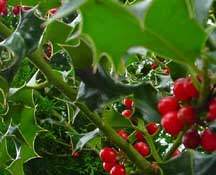
HEATHER
Common Name: Heather
Genus: Calluna
Exposure: Full sun
Hardiness: Hardy
Soil type: acidic, sandy, well-drained/light
Height: 0.5m
Spread: 0.6m
Flowering period: Nov-Mar
Heather have a very long flowering period over the winter when there is little other colour in the garden. There are many varieties to choose from ranging from white to deep purple/red.
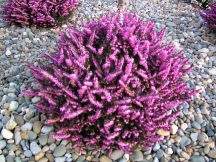
HELLEBORE
Common Name: Hellebore
Genus: Helleborus
Exposure: Full sun, Partial shade, Shade
Hardiness: Hardy
Soil type: Well-drained/light, Clay/heavy, Dry, Moist
Height: 80cm
Spread: 45cm
Flowering Period: Mid winter and late spring
A compact, evergreen perennial, this species has more finely divided, elegant foliage than most hellebores. In spring the almost ferny clumps are joined by clusters of nodding, lime-green flowers held on thick stems just above the tops of the foliage. The flowers last for several months.
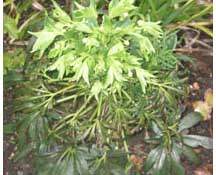
AFRICAN BLUE LILY
Common Name: African blue lily
Genus: Agapanthus
Exposure: Full sun
Hardiness: Hardy
Soil type: Well-drained/light, Moist
Height: 80cm
Spread: 45cm
Flowering period: July to September
A clump-forming, evergreen perennial with strap-like leaves. In late summer, trumpet-shaped, deep blue flowers are produced in rounded umbels. Plants work well when planted en masse in the border or in a large container on the patio. They enjoy a sunny position in moist but well-drained soil.
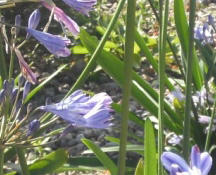
RHODODENDRON
Common Name: Rhododendron
Genus: Rhododendron
Exposure: Full sun, Partial shade
Hardiness: Hardy
Soil type: Well-drained/light, Acidic, Moist
Height: 400cm
Spread: 400cm
These are wonderful flowering plants with many varieties to choose from. Rhododendron is great for adding some early colour to the spring garden. You could have flowers from January to May depending on the variety you choose.
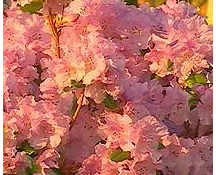
CAMELLIA
Common Name: Camellia
Genus: Camellia
Exposure: Partial shade, Shade
Hardiness: Hardy
Soil type: Well-drained/light, Acidic, Moist
Height: 900cm
Spread: 800cm
Flowering period: March to May
Camellia is one of the classic spring-flowering shrubs with colourful waxy flowers over fine glossy foliage. Even after flowering it is a decorative evergreen for the remainder of the year. It does need an acid soil but even if your soil is limey, it grows superbly in a large tub filled with ericaceous, or lime-free compost.
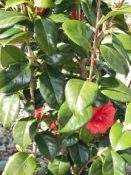
HYDRANGEA
Common Name: Hydrangea
Genus: Hydrangea
Exposure: Full sun, Partial shade
Hardiness: Hardy
Soil type: Well-drained/light, Clay/heavy
Height: 300cm
Spread: 300cm
The large flower-heads are borne in late summer when the shrub border so often short of flowers. Most popular are the mopheads with large ball like blooms. They like good soil, plenty of water and some protection against heavy frost.
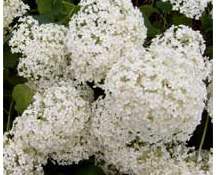
HEBE
There are a number of different species of Hebe but generally growing to a height of between 40-200cm depending on the variety and 100cm wide. They have narrow leaves, with its branches growing upright. They grow in a slightly rounded shape which is excellent as a structural plant in sunny locations. The flowers are white, pink or purple in colour.

POTENTILLA
Potentilla are deciduous shrubs. They flower for a long period of time, beginning at the end of spring and some continuing into the autumn. They prefer to grow in the sun, except for the red, pink or orange flowered potentillas which fade in the sun. Herbaceous low growing potentillas grow to about 30cm. Small shrub types grow to about 1.5m tall. The flowers of the species have five petals and come in a variety of colours from yellow through to pink and red.
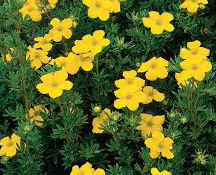
PITTOSPORUM
Pittosporum has a glossy, leathery, mid-green leaf and bell shaped black-red scented flowers. In mild climates it can be grown as specimen plants. It is good for shaping. It prefers morning and evening sun with partial shade for the rest of the day and fresh, fertile soil. It grows to a height of 4-10m and flowers between February and May.

LILY OF THE VALLEY BUSH
Common Name: Lily of the valley bush
Genus: Pieris
Exposure: Full sun, Partial shade, Shade
Soil type: Well-drained/light, Acidic, Moist
Height: 400cm
Spread: 300cm
Flowering period: April – May
Best in acid or neutral soils, pieris are essential spring border shrubs. Elsewhere, they will grow exceptionally well in containers of lime-free, ericaceous compost. This splendid shrub which will succeed in gardens where rhododendrons thrive. The evergreen foliage is dense and in April or May the long sprays of blooms which look like lily of the valley appears. The real glory of the most popular varieties is the bright red new growth in the spring.
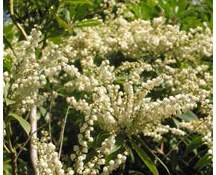
VIBURNUM TINUS
Common Name: Viburnum Tinus
Exposure: Full sun,
Soil type: Well cultivated soil
Height: 6-10 ft
Flowering period: Dec – April
This is a winter flowering evergreen, 6-10 ft high. It produces clusters of pink buds and then small white flowers between December and April. Useful for ground cover, screening, specimen plants and bushes for shrub borders. They are easy to grow and will succeed in chalky soil. No need for pruning and are very hardy.
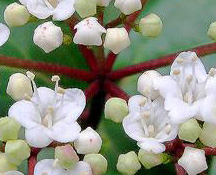
DAY LILY
Common Name: Day lily
Genus: Hemerocallis
Exposure: Full sun/light shade
Soil type: Any reasonable soil
Height: 90cm
Spread: 90cm
In recent years a vast array of hybrids have been developed. There is now a vast array of colours and flower shapes available. They grow very easily all that is required is a moisture- retentive soil and they will grow almost anywhere. Above the strap like leaves arise the branching flower stalks in summer. Each bloom usually lasts for a single day but new ones continue to open for many weeks.
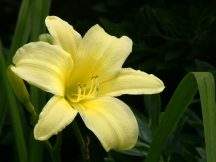
If you have any questions, please do reach out to us by phone +353 87 277 3492 or email for answers.









